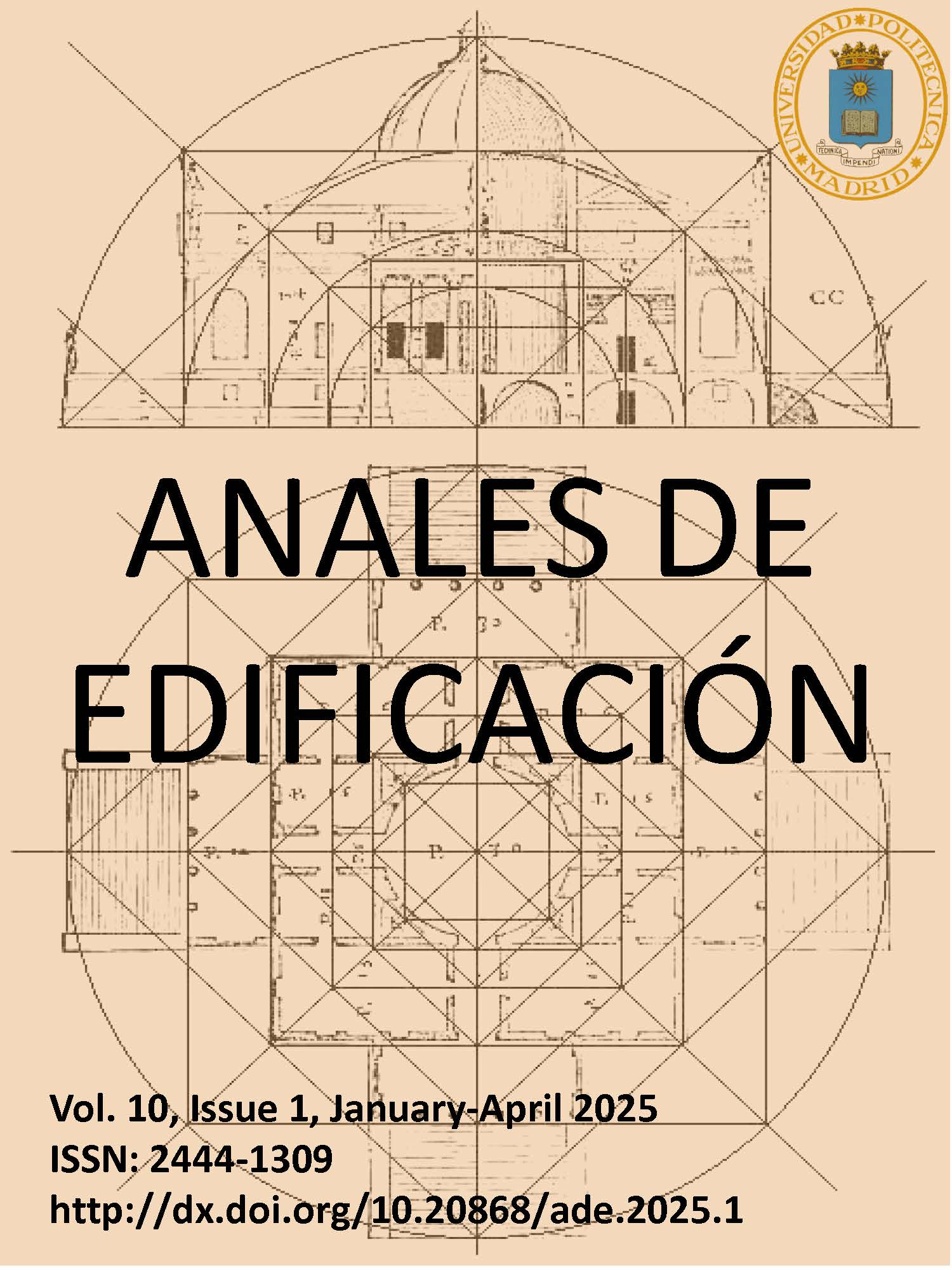Estimación del asiento elástico producido por la excavación de un túnel mediante un método de los elementos finitos
DOI:
https://doi.org/10.20868/ade.2025.5385Resumen
El trabajo que se presenta comprende el modelado mediante un método de los elementos finitos (en adelante MEF) para estimar el asiento elástico producido por la excavación de un túnel en un medio granular poroso sobre un estrato supuesto perfectamente impermeable. A su vez, sobre el estrato impermeable, el citado medio poroso se divide en dos estratos con diferente grado de saturación. En contacto con la capa superior se encuentran edificios aportando una carga superficial conjunta de 0,10 MPa. A una cierta profundidad y a cierta distancia horizontal respecto de la cimentación, se proyecta la excavación del túnel de 10 metros de diámetro. Se modela un FEM 2D con el empleo de las herramientas GMSH y MATLAB®. Se calculan los desplazamientos ocurridos en el terreno entre el estado inicial y el final. Para el cálculo de asientos se ha implementado en el MEF el principio de Terzaghi.
Descargas
Referencias
1. Arduino, P. (1996). Multiphase description of deforming porous media by the finite element method. Georgia Institute of Technology.
2. Berrocal, L. O. (2004). Elasticidad. McGraw-hill.
3. Boscardin, M. D., & Cording, E. J. (1989). Building response to excavation-induced settlement. Journal of Geotechnical Engineering, 115(1), 1-21. https://doi.org/10.1061/(ASCE)0733-9410(1989)115:1(1)
4. Bai, Y., Yang, Z., & Jiang, Z. (2014). Key protection techniques adopted and analysis of influence on adjacent buildings due to the Bund Tunnel construction. Tunnelling and Underground Space Technology, 41, 24-34. https://doi.org/10.1016/j.tust.2013.11.005
5. Di, H., Zhou, S., Xiao, J., Gong, Q., & Luo, Z. (2016). Investigation of the long-term settlement of a cut-and-cover metro tunnel in a soft deposit. Engineering Geology, 204, 33-40. https://doi.org/10.1061/(ASCE)CF.1943-5509.0000880
6. Dirección General de Arquitectura, Vivienda y Suelo. (2019). Código Técnico de la Edificación. Documento Básico. Seguridad Estructural. Cimientos. CTE-SE-DBSE-C. Ministerio de Fomento. Gobierno de España: Madrid, Spain. Disponible en la web: www.codigotecnico.org/pdf/Documentos/SE/DBSE-C.pdf (consultado el 15 de marzo de 2021).
7. Dirección General de Ferrocarriles. (2007). Orden Circular nº4/2007. Criterios Para el diseño de Revestimientos, Soleras y Contrabóvedas en Túneles Ferroviarios. Ministerio de Fomento, Gobierno de España: Madrid, Spain. Disponible en la web: www.mitma. gob.es/recursos_mfom/ordenc42007mf.pdf (consultado el 15 de marzo de 2021)
8. Geuzaine, C., & Remacle, J. F. (2009). Gmsh: A 3‐D finite element mesh generator with built‐in pre‐and post‐processing facilities. International journal for numerical methods in engineering, 79(11), 1309-1331. https://doi.org/10.1002/nme.2579
9. González, J. A., Lee, Y. S., & Park, K. C. (2017). Stabilized mixed displacement–pressure finite element formulation for linear hydrodynamic problems with free surfaces. Computer Methods in Applied Mechanics and Engineering, 319, 314-337. https://doi.org/10.1016/j.cma.2017.03.004
10. González, J. A., Park, K. C., & Felippa, C. A. (2007). FEM and BEM coupling in elastostatics using localized Lagrange multipliers. International journal for numerical methods in Engineering, 69(10), 2058-2074. https://doi.org/10.1002/nme.1833
11. Hansbo, P., & Juntunen, M. (2009). Weakly imposed Dirichlet boundary conditions for the Brinkman model of porous media flow. Applied Numerical Mathematics, 59(6), 1274-1289. https://doi.org/10.1016/j.apnum.2008.07.003
12. Korsawe, J., Starke, G., Wang, W., & Kolditz, O. (2006). Finite element analysis of poroelastic consolidation in porous media: Standard and mixed approaches. Computer Methods in Applied Mechanics and Engineering, 195(9-12), 1096-1115. https://doi.org/10.1016/j.cma.2005.04.011
13. Larese, A., Rossi, R., & Oñate, E. (2015). Finite element modeling of free surface flow in variable porosity media. Archives of Computational Methods in Engineering, 22, 637-653. https://doi.org/10.1007/s11831-014-9140-x
14. Liu, W. K., Li, S., & Park, H. S. (2022). Eighty years of the finite element method: Birth, evolution, and future. Archives of Computational Methods in Engineering, 29(6), 4431-4453. https://doi.org/10.1007/s11831-022-09740-9
15. Nikvar Hassani, A., Katibeh, H., & Farhadian, H. (2016). Numerical analysis of steady-state groundwater inflow into Tabriz line 2 metro tunnel, northwestern Iran, with special consideration of model dimensions. Bulletin of Engineering Geology and the Environment, 75, 1617-1627. https://doi.org/10.1007/s10064-015-0802-1
16. Olivella, X. O., & de Saracibar, C. A. (2002). Mecánica de medios continuos para ingenieros (Vol. 92). Univ. Politèc. de Catalunya.
17. París, F. (1998). Teoría de la elasticidad. Escuela Superior de Ingenieros Industriales. Grupo de Elasticidad y Resistencia de Materiales.
18. Rallu, A., Berthoz, N., Charlemagne, S., & Branque, D. (2023). Vibrations induced by tunnel boring machine in urban areas: In situ measurements and methodology of analysis. Journal of Rock Mechanics and Geotechnical Engineering, 15(1), 130-145. https://doi.org/10.1016/j.jrmge.2022.02.014
19. Rodríguez, C. A., Rodríguez-Pérez, Á. M., López, R., Hernández-Torres, J. A., & Caparrós-Mancera, J. J. (2023). A Finite Element Method Integrated with Terzaghi’s Principle to Estimate Settlement of a Building Due to Tunnel Construction. Buildings, 13(5), 1343. https://doi.org/10.3390/buildings13051343Sandström, C., Larsson, F., Runesson, K., & Johansson, H. (2013). A two-scale finite element formulation of Stokes flow in porous media. Computer Methods in Applied Mechanics and Engineering, 261, 96-104. https://doi.org/10.1016/j.cma.2013.03.025
20. Su, K., Zhou, Y., Wu, H., Shi, C., & Zhou, L. (2017). An analytical method for groundwater inflow into a drained circular tunnel. Groundwater, 55(5), 712-721. https://doi.org/10.1111/gwat.12513
21. Terzaghi, K., Peck, R. B., & Mesri, G. (1996). Soil mechanics in engineering practice. John wiley & sons.
22. Tian, X., Song, Z., & Wang, J. (2019). Study on the propagation law of tunnel blasting vibration in stratum and blasting vibration reduction technology. Soil Dynamics and Earthquake Engineering, 126, 105813. https://doi.org/10.1016/j.soildyn.2019.105813
23. Wang, L., Zhang, X., Zhang, S., & Tinti, S. (2021). A generalized Hellinger-Reissner variational principle and its PFEM formulation for dynamic analysis of saturated porous media. Computers and Geotechnics, 132, 103994. https://doi.org/10.1016/j.cageo.2018.11.002
24. Wang, J., & Ye, X. (2016). A weak Galerkin finite element method for the Stokes equations. Advances in Computational Mathematics, 42(1), 155-174. https://doi.org/10.1007/s10444-015-9415-2
25. Zienkiewicz, O. C., & Taylor, R. L. (2005). The finite element method for solid and structural mechanics. Elsevier.
26. Zienkiewicz, O. C., Taylor, R. L., & Nithiarasu, P. (2013). The finite element method for fluid dynamics. Butterworth-Heinemann.
Descargas
Publicado
Número
Sección
Licencia
Derechos de autor 2025 Autor / BY-NC

Esta obra está bajo una licencia internacional Creative Commons Atribución-NoComercial-SinDerivadas 4.0.
1. Los autores conservan los derechos de autor y garantizan a la revista el derecho de una Licencia Creative Commons Atribución - Nocomercial 4.0 Internacional que permite a otros compartir el trabajo con un reconocimiento de la autoría y uso no comercial.
2. Los autores pueden establecer por separado acuerdos adicionales para la distribución no exclusiva de la versión de la obra publicada en la revista (por ejemplo, situarlo en un repositorio institucional o publicarlo en un libro).
Salvo indicación contraria, todos los contenidos de la edición electrónica se distribuyen bajo una licencia de uso y distribución “Creative Commons"












